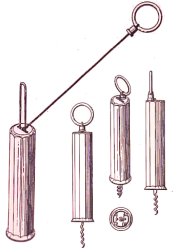

The Virtual Corkscrew Museum's Daily Newspaper
|
Thursday, April 10, 2003 |

So What's New?
Neuilly, France, April 10, 1990 - Bruno Desnoulez and Andre Dejoux patented a tackle reduction corkscrew back in 1983. The original design has a pulley system. A handle is attached to the pulley via a "rope" which pulls a cork out when the handle and a series of telescoping tubes are lifted. The mechanical patent (No. 4,93,733) acknowledges the 1908 German patent (No. 204,020) by Klostermann and a 1970 French Patent (No. 1,589,350 by Aimé Ceppe.
In discussing the Klostermann and Ceppe patents, Bruno and Andre state "The embodiment of these corkscrews is complicated and onerous; moreover, they generate friction that cause a part of the gain in the reduction of the removal effort to be lost." In their 1983 they cover three different designs including a t-handle telescoping version and a ring pull version.
Today Bruno received United States Design Patent Number D307,102 for a casing design for the 1983 patent. His patent was assigned to Anne-Marie Prevost in Paris. The design application was filed in 1987 and it is already being marketed under the names "Kariba" and "Liftboy. The "barrels" are plastic and are available in red, white, black and silver.
From left to right:
Klostermann's 1908 German Patent
Ceppe's 1970 French Patent
Desnoulez and Dejoux 1983 United States Patent
Columbus Day
Solingen, Germany, April 10, 1894 - Eduard Becker was issued German Patent #70879 on March 7, 1893 for his "Columbus" Corkscrew. He subsequently received English Patent #17,924 October 28, 1893. Now he has been granted American Patent #518,018 for this corkscrew. The ring hold the split barrel together during cork removal. Once the cork is removed from the bottle, the ring is moved up, the sides split and the cork can be removed from the worm. The spring between the handle and the frame assists the extraction by exerting pressure on the handle to gradually withdraw the cork.
Becker says "My invention includes a movable frame on the spindle of the screw made in two parts, adapted to clamp or engage the neck of the bottle and spring between the frame and the handle of the screw arranged to exert its force to draw the cork by moving the spindle through the frame."
Answer to Yesterday's "What is this?":
|
©2003 Don Bull, Editor |